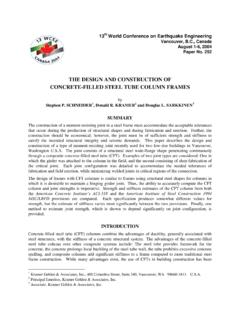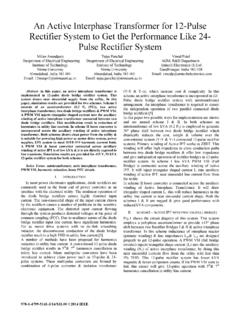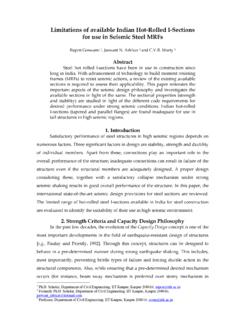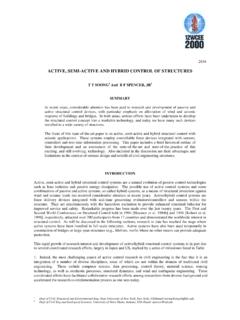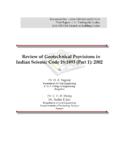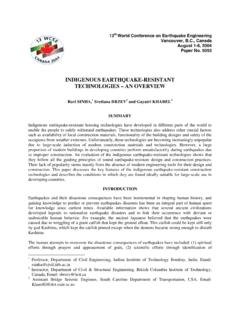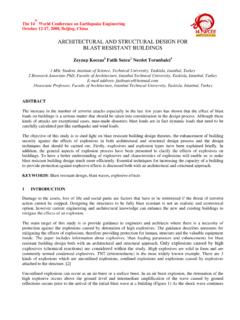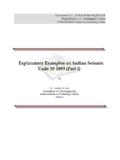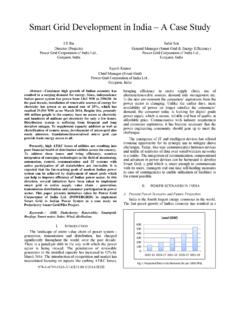Transcription of Fuzzy Sets ( Type-1 and Type-2) and their Applications
1 Fuzzy Sets ( Type-1 and Type-2). and their Applications Presented by Prof. U. S. Tiwary, IIIT Allahabad (for self use only). Why Fuzzy Sets It enables one to work in uncertain and ambiguous situations and solve ill-posed problems or problems with incomplete information Example : Fuzzy Image Processing (Humanlike). Human visual system is perfectly adapted to handle uncertain information in both data and knowledge It will be hard to define quantitatively how an object , such as a car, has to look in terms of geometrical primitives with exact shapes, dimensions and colors.
2 We use descriptive language to define features that eventually are subject to a wide range of variations. 3. Fuzzy Reasoning and Probability They are related , but complimentary to each other. Say, for example , if we have to define the probability of appearance of an edge in few frames of images, we have to define, what is an edge. Certain threshold for rate of variation has to be taken, which may not be true for other images or noisy images. Fuzzy logic, unlike probability, handles imperfection in the informational content of the event.
3 4. Two frameworks for Fuzzy Systems 1) Development based on Crisp mathematical model and fuzzifying some quantities : Model 1 : Fuzzy Mathematical Model Example : Fuzzy K means clustering 2) Development based on Fuzzy Inference rules: Model 2 : Fuzzy Logical Model Example : Fuzzy decision Support System 1. Definition of Fuzzy set Concept for Fuzzy set Definition (Membership function of Fuzzy set). In Fuzzy sets, each elements is mapped to [0,1]. by membership function. A : X [0, 1]. Where [0,1] means real numbers between 0 and 1 (including 0 and 1).
4 1 Definition of Fuzzy set Example A A. X a a b b c c d d A A. 1 1. a b c d x x a b c d Fig : Graphical representation of crisp set Fig : Graphical representation of Fuzzy set 1 Definition of Fuzzy set Example Consider Fuzzy set two or so'. In this instance, universal set X are the positive real numbers. X = {1, 2, 3, 4, 5, 6, }. Membership function for A = two or so' in this universal set X is given as follows: A(1) = , A(2) = 1, A(3) = , A(4) = 0 . A. 1. 1 2 3 4. 1. Examples of Fuzzy set and linguistic terms A= "young" , B="very young".
5 M e m be rship very yo un g you ng 10 20 27 30 40 50 60 age Fig : Fuzzy sets representing young and very young . 1. Examples of Fuzzy set A ={real number near 0}. 1. A A (x) x where A(x) = 1 x 2. (x). 1. x -3 -2 -1 0 1 2 3. Fig : membership function of Fuzzy set real number near 0 . 2. Expansion of Fuzzy set Type-n Fuzzy Set The value of membership degree might include uncertainty. If the value of membership function is given by a Fuzzy set, it is a type-2 Fuzzy set. This concept can be extended up to Type- n Fuzzy set. Example (Type-n Fuzzy Set ).
6 Fuzzy sets of type 2 : : the set of all ordinary Fuzzy sets that can be defined with the universal set [0,1]. is also called a Fuzzy power set of [0,1]. Fig : Fuzzy Set of Type-2. 2. Operators: Fuzzy complement Requirements for complement function Complement function C: [0,1] [0,1]. A ( x) C ( A ( x)). (Axiom C1) C(0) = 1, C(1) = 0 (boundary condition). (Axiom C2) a,b [0,1]. if a b, then C(a) C(b) (monotonic non-increasing). (Axiom C3) C is a continuous function. (Axiom C4) C is involutive. C(C(a)) = a for all a [0,1]. Fuzzy complement Example of complement function C ( A ( x )).
7 1. C ( A ( x)) 1 A ( x). 1 A(x). Fig : Standard complement set function Fuzzy complement Example of complement function Yager complement function C w ( a ) (1 a ) w 1/ w w ( 1, ). w=5. Cw(a) w=2. w=1. w= a Fuzzy union Axioms for union function U : [0,1] [0,1] [0,1]. A B(x) = U[ A(x), B(x)]. (Axiom U1) U(0,0) = 0, U(0,1) = 1, U(1,0) = 1, U(1,1) = 1. (Axiom U2) U(a,b) = U(b,a) (Commutativity). (Axiom U3) If a a' and b b', U(a, b) U(a', b'). Function U is a monotonic function. (Axiom U4) U(U(a, b), c) = U(a, U(b, c)) (Associativity).
8 (Axiom U5) Function U is continuous. (Axiom U6) U(a, a) = a (idempotency). Fuzzy union Examples of union function U[ A(x), B(x)] = Max[ A(x), B(x)], or A B(x) = Max[ A(x), B(x)]. A B. 1 1. X X. A B. 1. X. Fig : Visualization of standard union operation Fuzzy union Yager's union function : U w (a, b) Min[1, ( a w b w )1 / w ] where w (0, ). 0 a 1 1 1 1 U1(a,b) = Min[1, a+b]. 1 1. w=1. 0 a 1 1 1 1 U2(a,b) = Min[1, a 2 b 2 ]. w=2. 0 a 1 1 1 1 U (a,b) = Max[ a, b] : standard union function w . Fuzzy intersection Axioms for intersection function I:[0,1] [0,1] [0,1].
9 A B ( x) I [ A ( x), B ( x)]. (Axiom I1) I(1, 1) = 1, I(1, 0) = 0, I(0, 1) = 0, I(0, 0) = 0. (Axiom I2) I(a, b) = I(b, a), Commutativity holds. (Axiom I3) If a a' and b b', I(a, b) I(a', b'), Function I is a monotonic function. (Axiom I4) I(I(a, b), c) = I(a, I(b, c)), Associativity holds. (Axiom I5) I is a continuous function (Axiom I6) I(a, a) = a, I is idempotency. Fuzzy intersection Examples of intersection standard Fuzzy intersection I[ A(x), B(x)] = Min[ A(x), B(x)], or A B(x) = Min[ A(x), B(x)]. A B. 1. X. Fuzzy intersection Yager intersection function I w (a, b) 1 Min[1, ((1 a ) w (1 b) w )1/ w ], w (0, ).
10 B 0 0 .2 5 0 .5. a 1 0 0 .2 5 0 .5 I 1 (a ,b ) = 1 -M in [ 1 , 2 - a - b ]. 0 .7 5 0 0 0 .2 5. 0 .2 5 0 0 0 w = 1. 0 0 .2 5 0 .5. a B. 1 0 0 .2 5 0 .5 I 2 (a ,b ) = 1 - M in [ 1 , (1 a ) 2 (1 b ) 2 ]. 0 .7 5 0 0 .2 1 0 .4 4. 0 .2 5 0 0 0 .1 w = 2. 0 0 .2 5 0 .5. a 1 0 0 .2 5 0 .5 I (a ,b ) = M in [ a , b ]. 0 .7 5 0 0 .2 5 0 .5. 0 .2 5 0 0 .2 5 0 .2 5 w . 3. Extension Principle The extension principle is a basic concept of Fuzzy set theory that provides a general procedure for extending crisp domains of mathematical expressions to Fuzzy domains.

